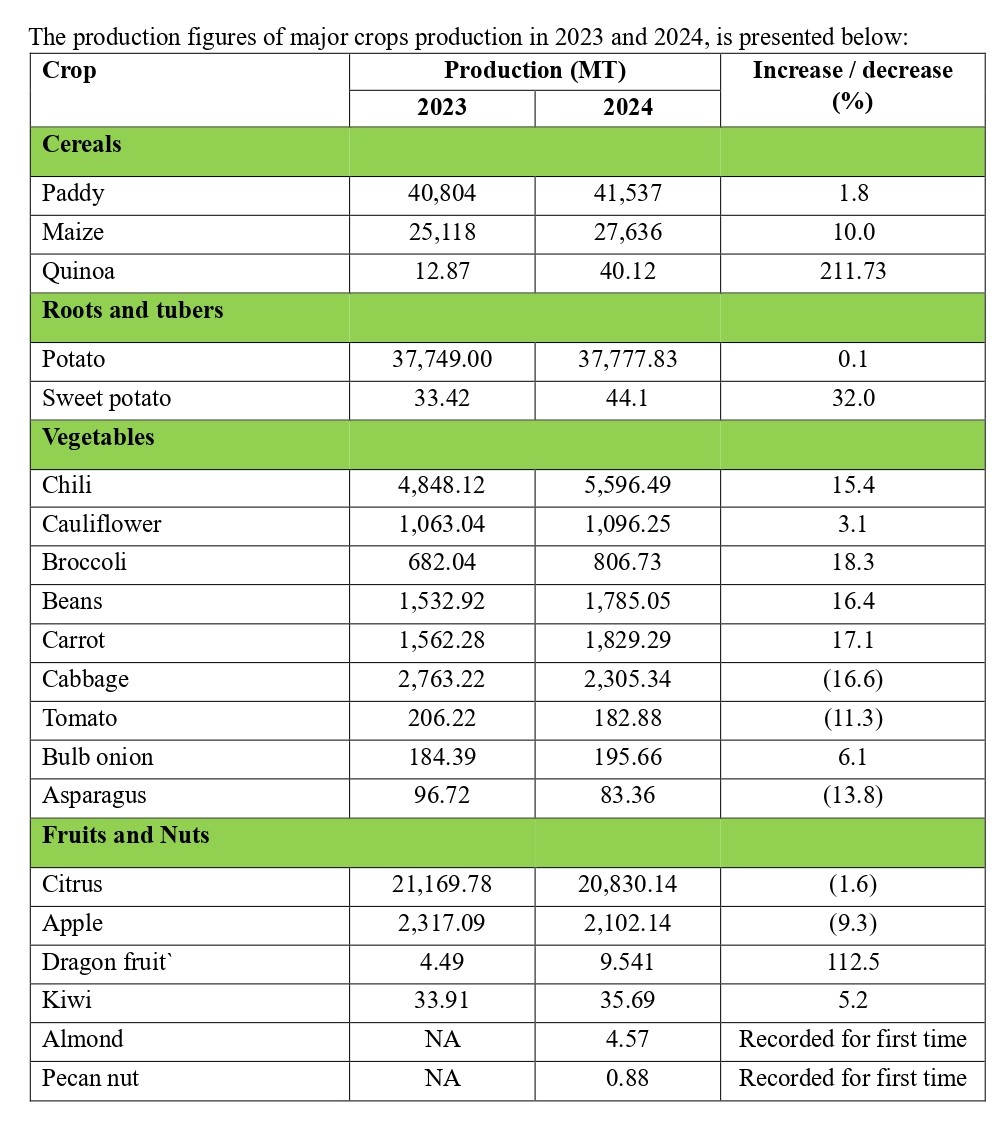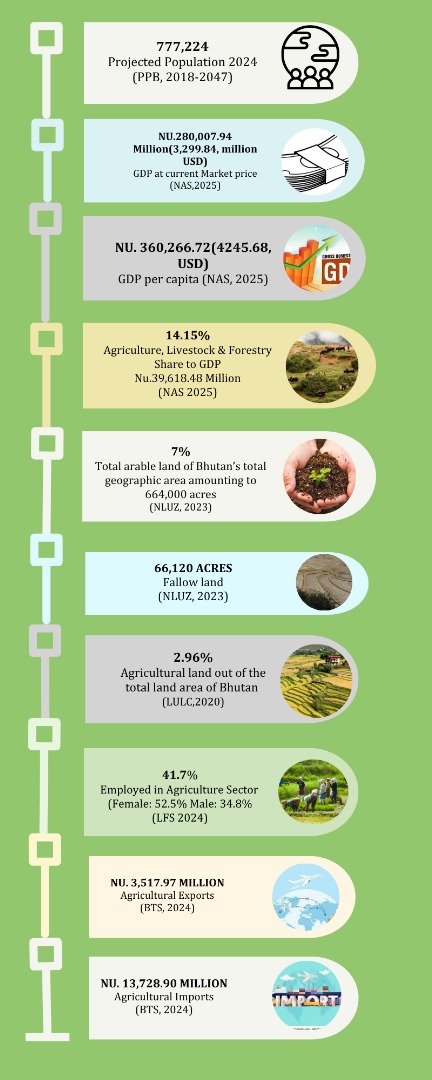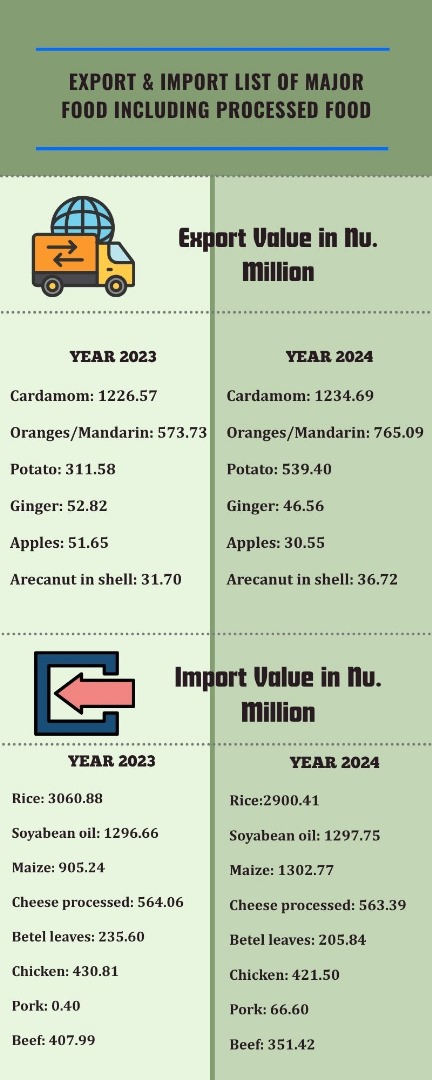The National Statistics Bureau (NSB) released the Integrated Agriculture and Livestock Census of Bhutan 2025 report on 3 July 2025.
- AGRICULTURE PRODUCTION
NSB reports overall improvement in crop production in 2024 compared to 2023. Production of major crops such as paddy, maize, quinoa, potato, vegetables, and fruits, has increased.
Similarly, in the vegetable sector, with the exception of tomato, asparagus, and cabbage, production of essential vegetables such as chili, cauliflower, beans, bulb onion, broccoli, and carrot increased. Notably, chili production increased by 15%, from 4,848.12 MT in 2023 to 5,596 MT in 2024, and bean production increased by 16%, from 1,532.92 MT to 1,784 MT.
Fruit crops—such as dragon fruit, kiwi, avocado, mango, passion fruit, lemon and lime, walnut, strawberry, and persimmon—reports marginal increase, and for the first time some of the new fruit crops – such as almond, chestnut, pecan nut and cherry – features in the report due to the Million Fruit Tree Plantation program, gift of His Majesty the King to the farmers. Almond production was 4.57 MT, chestnut 0.71 MT, pecan nut 0.88 MT and cherry 0.22 MT. In the coming years, more new high value fruits expected to be reported.
The overall improvement in production has been due to favourable climatic conditions in 2024, besides intervention from the government in the form of irrigation infrastructure, chain-link fencing, agriculture land development and provision of mini power-tiller.
However, production of apples and citrus fruits report a decline due to aging orchard, pest and disease and shift to new high value fruits and nuts supplied through the Million Fruit Tree Plantation program. In addition, Tsirang, one of the major citrus-producing Dzongkhag, experienced an unusual hailstorm during the citrus flowering stage, resulting in an estimated reduction of about 160 MT in April 2024. Some reduction is also reported in oilseeds and legumes.

- LIVESTOCK PRODUCTION
The livestock sector witnessed a modest growth in livestock production despite challenges such as recurrent disease outbreaks, human wildlife conflicts and climate impacts.
A total of 44,038 metric tons (MT) of milk was produced in 2024, compared to 43,828.51 MT in 2023, which is 0.5% increase. Butter production remained stable at 1,695 MT, Cheese production increased by 11%, from 2,326 MT in 2023 to 2,584 MT in 2024. Chugo production increased from 132 MT in 2023 to 193 MT in 2024.
A total of 98.2 million table eggs were produced in 2024, a 14.6% increase from 85.7 million eggs in 2023. This increase is likely due to improved management practices and strengthened biosecurity measures by poultry farmers in addition to the continued supply of layer day-old-chicks (DoCs) from Government input farms based on farmers’ demands.
The total meat production (chicken, pork and fish) recorded in 2024 was 2821.67 MT. Chicken production increased by 3.7%, reaching 1,208.23 MT compared to 1,165.12 MT in 2023, indicating a steady growth in the sector. Fish production also recorded a notable rise of 34%, increasing from 43.26 MT in 2023 to 57.99 MT in 2024. Pork production showed a slight decline of 2%, from 1,590.47 MT in 2023 to 1,555.45 MT in 2024. The decline in pork production is attributed to recurrent outbreaks of African Swine Fever (ASF) in the country. During 2024, a total of 7 ASF outbreaks reported in the country.
Chevon production was recorded at 210.03 MT, while mutton production was 19.29 MT. Likewise, the beef, yak and buffalo meat production were reported at 1,270.64 MT, 141.05 MT and 7.92 MT, respectively. Meanwhile, wool production (yak and sheep) was 10.8 MT, which is a 23.6% increase compared to 2023. Honey production increased to 54.9 MT in 2024 from 41.7 MT in 2023, which is a 31% increase. This growth was largely driven by the expansion of apiculture support programs. The livestock population recorded in 2024 was 218,438 Cattle, 29,432 Yak, 8,560 Zo/Zom, 10,499 equine, 34,059 pig, 924,488 poultry, 9,176 sheep and 55,803 goats. As compared to 2023, the cattle population has decreased by 2%, goat by 8%, while the pig population has increased by 14% and poultry by 13%.
Full report can be accessed at: www.nsb.gov.bt

![]()



